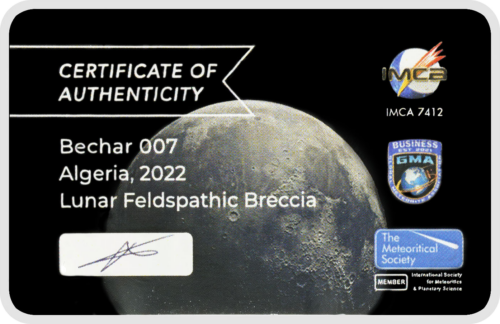



Meteorite Origin: Algeria
Meteorite Type: Lunar Meteorite
Weight: 1 - 3 g
A moon meteorite is a rock originating from the surface of the Moon that has fallen to Earth. Such meteorites are formed when a large meteoroid or asteroid hits the Moon (impact speed must reach 12-40 km/s) and ejects rock fragments into space.
The Moon lacks an atmosphere to protect it from meteoroid impacts. As a result, its surface is bombarded daily by meteoroids. Without atmospheric protection, impacts on the Moon’s surface are much stronger and more frequent than on Earth. These impacts eject rocks, which, depending on the impact force and trajectory, can end up in space.
Although the Moon is constantly bombarded by meteoroids, only a small fraction of the ejected rocks reach Earth. Most of them travel into space or fall into the Sun's gravitational field. Scientists estimate that only about 0.7% of all found meteorites are from the Moon. For comparison, the majority (about 99%) are fragments of other asteroids, and an even smaller portion (0.5%) is from Mars.
Moon meteorites are most commonly found in deserts, where the effects of rain and erosion are minimal. Some known locations include North Africa, Algeria, Oman, and Antarctica.
A meteoroid traveling towards Earth breaks into dozens, hundreds, or even thousands of pieces due to friction and high speed. All these fragments, originating from the same body, fall into a specific and limited area called a Strewn Field. Meteorite hunters explore the fall area to identify and find as many meteorite fragments as possible, including both large and small specimens. All collected meteorites are sent to a research center in the USA (Appalachian State University), where they are analyzed and confirmed in a scientific database.
Burned crust: Moon meteorites often have a characteristic “burned crust” layer formed during their flight through Earth's atmosphere.
Cosmogenic isotopes: All meteorites, including lunar ones, contain certain isotopes that form only in cosmic rays outside Earth's atmosphere. The presence of these isotopes can be confirmed through laboratory tests.
Mineral composition: Moon meteorites have a unique mineral composition that distinguishes them from Earth rocks.
We offer you a unique opportunity to feel the wonder of space and have a piece of the Moon in your hands – buy an authentic Moon meteorite! Our meteorites are carefully selected and certified by the International Meteorite and Planetary Society (IMCA), a renowned scientific organization studying meteorites, comets, asteroids, and other cosmic objects since 1955.
Each meteorite we offer is special and has its own unique story. By clicking the link next to each meteorite, you can learn all about its origin, discovery location and time, chemical composition, classification, physical properties, petrography, and geochemistry.
https://www.lpi.usra.edu/meteor/metbull.php?code=79249